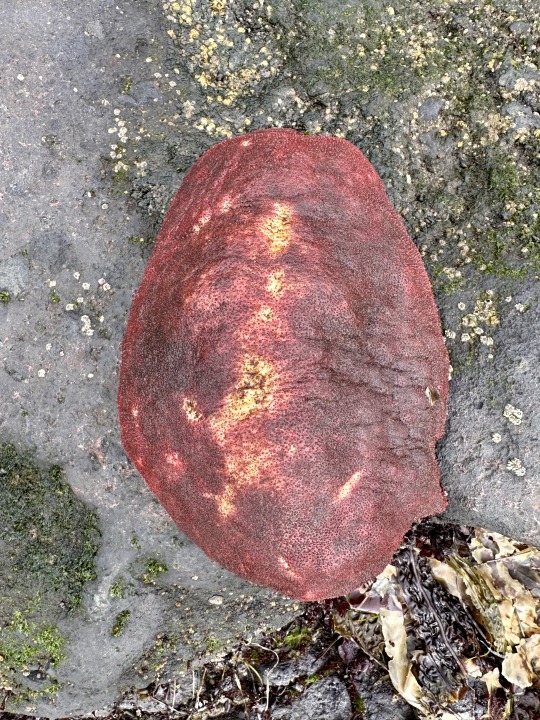#gumboot chiton
Text
Wet Beast Wednesday: chitons
For last week's Wet Beast Wednesday I talked about a weird invertebrate whose name starts with "c" so this week I'm gonna branch out from that and talk about a weird invertebrate whose name starts with a "c". Chitons are marine mollusks of the class Polyplacophora that bear a resemblance to limpets, but have a segmented shell that allows for more flexibility. They are named after a form of clothing worm by the ancient Greeks.
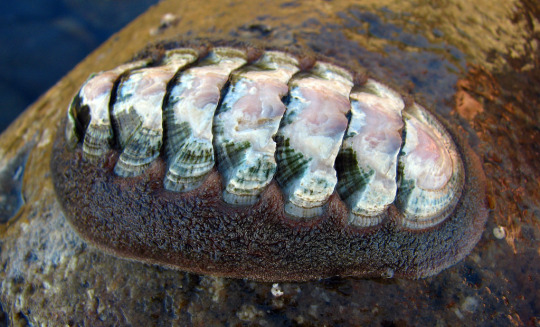
(image id: a chiton. It is an oval animal with a flat shell composed if 8 overlapping green and white plates. Surrounding the shell is brown, soft tissue)
Chitons are similar in appearance and ecology to limpets, though they are not closely related. The shell of a chiton is made of 8 plates called valves. Valves are the name of any mollusk shell that is divided into multiple pieces. Most mollusk shells are made of one continuous piece and the only ones that have valves are the chitons, bivalves, and a few weird snails. The valves of a chiton overlap slightly, allowing for flexibility while still giving protection. Chitons can curl up into balls and flex backwards to move over concave surfaces that limpets wouldn't be able to. The valves are imbedded in and held together by a thick, muscular ring called the girdle that encircles the body. In most species, only the sides of the valves are covered by the girdle, leaving the rest exposed to the water. A few species cover more or all of the valves with the girdle. When a chiton dies and the girdle decays, the valves will separate. Individual valves sometimes wash up on beaches and are called butterfly shells due to their v-shaped appearance. The shell is used for defense. Chitons can curl up in a ball when not attached to a rock. If one is attached to a rock, it can suction on, presenting predators with no good way to attack its soft underbelly. Some species have spikes, bristles, or other ornaments on their valves and girdles that can provide additional protection.
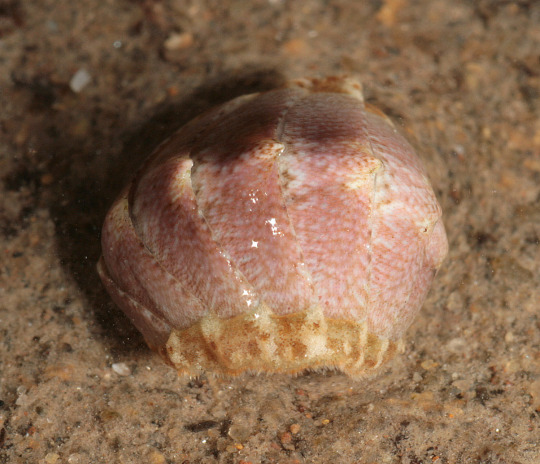
(image: a chiton curled up into a ball. Its plates are pale pink and its girdle is white and brown)
Underneath the shell, the chiton's body is soft. It consists largely of a muscular foot that is used for movement. To either side of the foot is the mantle cavity, which consists of channels filled with gills that water is pulled through. There is no distinct head, but a mouth is present on the front end. Inside the mouth is the radula, a tongue-like appendage that is covered in teeth. The teeth are special because they are coated in magnetite, a very hard magnetic mineral that has iron as one of its main ingredients. While the metal is used to reinforce the teeth and keep them from wearing out (in fact, the chiton Chaetopleura apiculata has the hardest teeth of any known animal), it may also be used for magnetoreception. This is when an animal can sense magnetic fields. It is possible that the magnetic teeth of chitons can sense the Earth's magnetic field and help with navigation and migration. Most chitons are herbivores or omnivores that feed on algae, bryozonans, diatoms, and other tiny rock-dwellers by scraping at rocks with their radulae. Some are carnivores that target barnacles and can even eat small crustaceans and fish. They often hunt by holding the front ends of their girdles up in the water. Should an animal mistake it for shelter, the chiton will clamp down on them. Food is forced through the esophagus by a current of mucus moved by cilia.

(image: the underside of a chiton. it is oval and orange all over. Two groves filled with brown gill filaments go down each side of the body, encircling a central foot. The mouth is visible as a small hole on one end)
When it comes to senses, chitons have a few options. Like their gastropod cousins, chitons have a chemosensory organ called the subradular organ used for smell and their feet and girdles are full of sensory nerves. They also have special organs called aesthetes. These consist of light-sensing cells that are just below the surface of the shell. The aesthetes are not true eyes, only being able to distinguish light from dark, though they can tell the difference between a shadow and the effects of clouds moving over the sun. Some species use collections of aesthetes to form simple eyes called shell eyes. Unlike the aesthetes, the shell eyes can form images, though Chitons do not have nerve structures needed to form a high resolution image. Shell eyes are distinct from those of any other animal in their structure. Most animals have eye lenses made of protein-based structures, but chiton lenses are crystalline, made of aragonite, the same material that makes up the shell of most mollusks. Each shell eye is compound. The shell eyes are almost certainly used for predator detection. Fossil chitons have been found dating back to the Cambrian period. but shell eyes have only been found in fossils from less than 10 million years old. This likely makes chitons the most recent animal group to have evolved true eyes. Chiton eyes have also been found to work both in water and air, which is tricky due to the way light travels differently through both mediums.
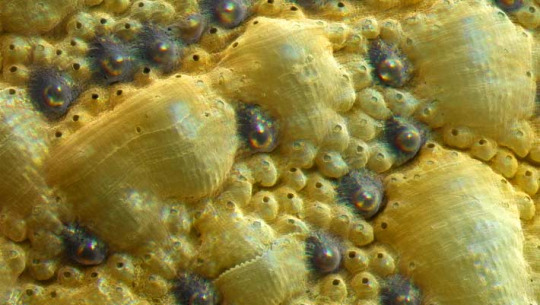
(image: a close-up of a chiton's shell showing the eyes. The shell is yellow and lumpy with the eyes visible as darker, almost black lumps)
The majority of chitons live in intertidal or sub-tidal areas, making them a shallow water group. A few species have been found living in much deeper water, up to 2,000 meters down. Chitons have been known to have homing behavior as they will consistently return to a safe spot after feeding. How they do this is unknown. Sensing the magnetic field of the Planet may play a role, though it is also possible that they lay down chemical trails to find their way home. Chitons are broadcast spawners, with both males and females releasing gametes into the water. Larvae can swim for a while before moving to the substrate.

(image: microscope images of a chiton larva at 4 different developmental stages. It begins as a round blob ringed with hair-like cilia. As the animal develops the cilia recede and the animal elongates, with a distinct foot becoming visible. source)
I will close by bringing up an animal I only learned about recently but has rapidly become one of my favorite weird beasts. This is Cryptochiton stelleri. Its common name is the gumboot chiton, but some people call it the wandering meatloaf, which is objectively the best name ever. It is the largest chiton, growing up to 36 cm (14 in) and 2 kg (4.4 lbs). Its girdle completely covers its shell, which does make it look more like a meatloaf. They can live up to 40 years and are the first known animals to have the mineral santabarbarite in their bodies. They live throughout the north pacific and have been used as a food source by many different cultures. There may be a lot of bad stuff in the world, but if things get too bad, just remember that we live on the same planet as an animal called the wandering meatloaf that can live for 40 years and has a tongue covered in magnetic teeth.

(image: a wandering meatloaf. It is an ovoid animal with red-orange tissue covering the body. Its shell is not visible, but the ridges where each plate overlaps can be seen through the girdle)
#wet beast wednesday#chiton#wandering meatloaf#gumboot chiton#mollusk#molluscs#marine biology#biology#zoology#ecology#animal facts#marine animals
432 notes
·
View notes
Text






Half Moon Bay, CA
#AAAAAAAAAHHHH#marine bio#sea star#starfish#ochre sea star#spotted dorid#sea anemone#gumboot chiton#chiton#nudibranch#sea lemon#abalone shell#kelp crab#tide pools#tidal pools#marine biology#oceancore#marine life#pacific ocean#crab#seashore#there are many benefits to being a marine biologist#ecology#seashell#🩻#seekdestr0y#my photos
326 notes
·
View notes
Photo

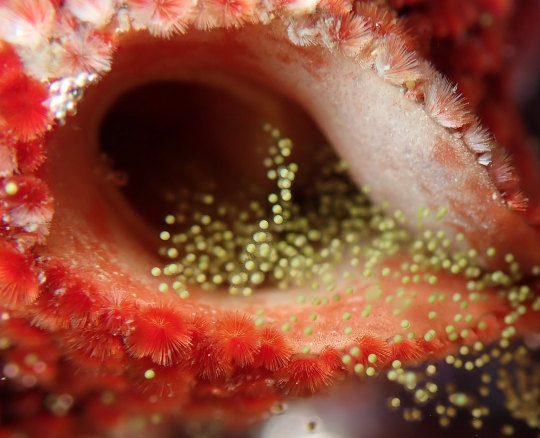



Gumboot Chiton female, spawning
138 notes
·
View notes
Text
It was a beach field trip sort of day …
😌🌊💙
#monterey bay aquarium#what if we met at the beach and got nerdy about whale skulls?#jk…unless#also gumboot chitons deserve more love
2K notes
·
View notes
Text
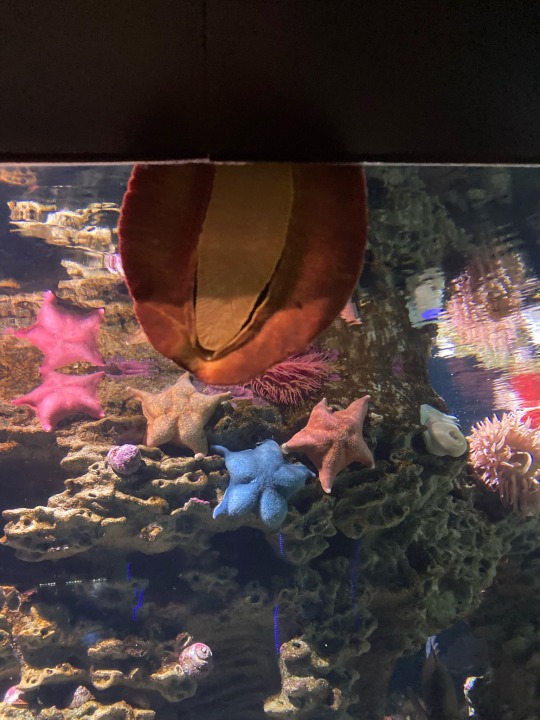
gumboot chiton sticking to the glass in one of the tanks at work btw. if you care
32 notes
·
View notes
Text
btw if you guys aren't familiar with the gumboot chiton
from the top they just kinda look like blobs
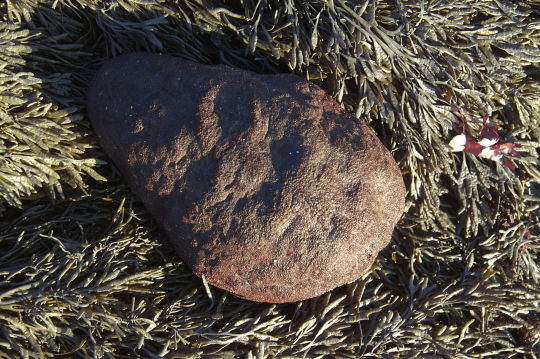
but you flip them over and...

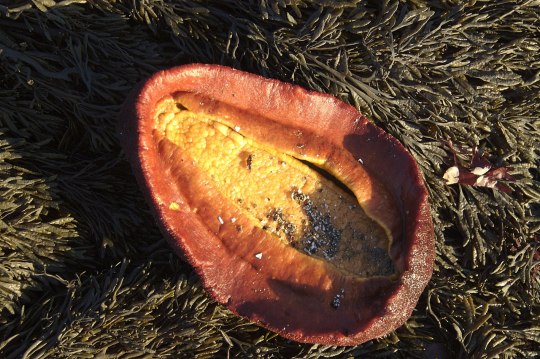
6 notes
·
View notes
Text
JOURNAL OF THE LIGHTHOUSE STATION AT CACHALOT COVE

[[ log 44 ]]
~Partly Cloudy Conditions from 0700-1220, Sunny Conditions All Day~
~Wind Speeds Up to 22 km/h~
Time of writing this log is 2155
Duties done at the station:
𓇼 Winding of the Clockworks
𓇼 Mail Check
𓇼 Grocery
Good evening logbook! Nothing super important was done today, however, some local kids came by asking to see the tide pools in the earlier hours of the day. Not wanting to leave them on their own to be washed to sea thanks to my sister, I did accompany them and also use this as a chance to teach them about being around these pools safely. The children even had the chance to see what humans call a gumboot chiton! We have another name for it, but it is difficult to translate, so I shall leave that my own little secret. I do apologize for keeping this short as I am exhausted.
May the Seas Guide You~~
#lighthousecore#sirencore#piratecore#siren aesthetic#lighthouse aesthetic#mermaid aesthetic#lighthouse#lighthouse keeper#ocean#oceancore#nautical#nauticalcore#seacore#ocean aesthetic#goblincore#coastal#cachalotcove#keeperslogbook
7 notes
·
View notes
Text
Seeing my friends post about the game awards after I spent a glorious day at the aquarium aquarium me in a certain mood where like. Nothing impresses me unless it is about the lush vibrant kelp forests off the central California coastline. Game of the year? No game can be game of the year unless it centers around the noble gumboot chiton.
2 notes
·
View notes
Text
Anthro Allies Remastered (Part 11)

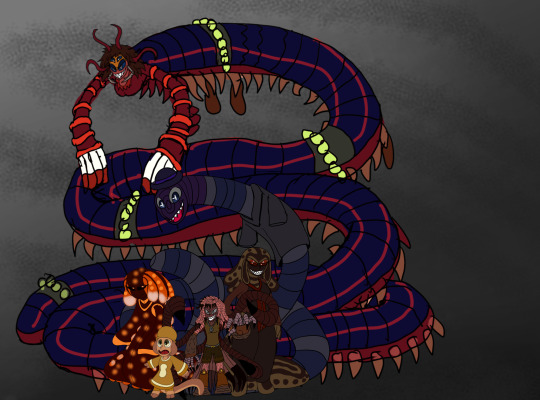
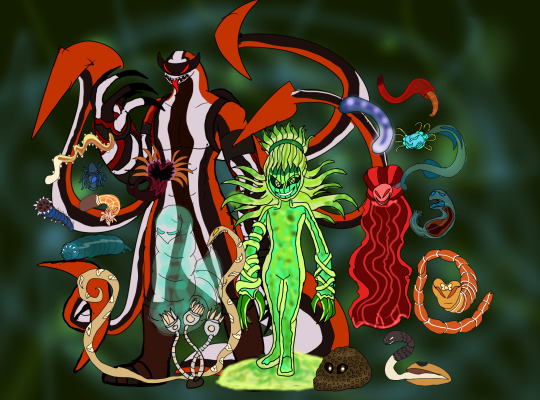
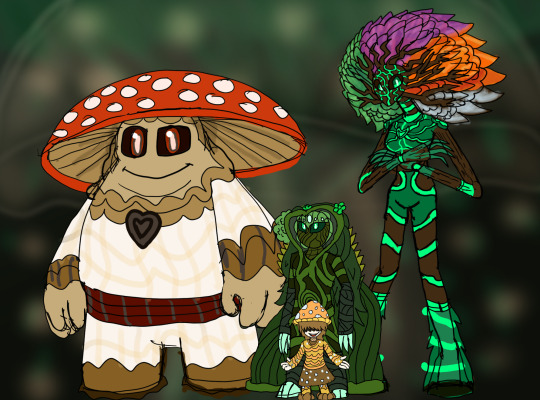
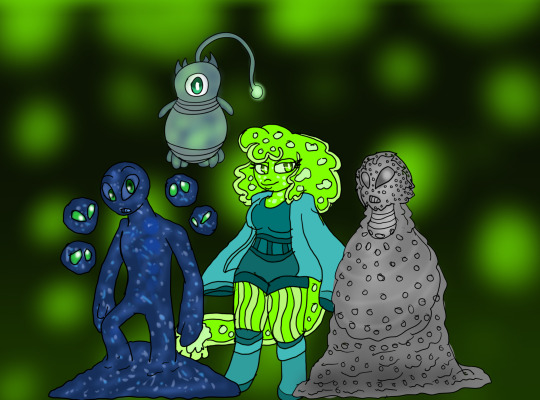
were at the home stretch we Got Mollusks, we got Annelids, Parasites, Flora, Fungi and Micro Organisms
Mollusks
Sync (Giant Octopus/Blue ringed)
Lakella (octopus hybrid)
Tihomier (vampire squid)
Silah (Squid hybrid)
Bobby (bobtail squid)
Cassandra (Cuttlefish)
Jubal (Ramshorn Squid)
Lozen (Nautilus)
Rosallyn (Snail)
Shankha (Garden snail/Horse conch)
Oozie (Sea slug)
Bryce (Land slug/Blue sea slug)
Ulysses (Bivalve hybrid)
Petunia (Bivalve Hybrid)
Lucian (Lined Chiton)
Gumshoe (Gumboot Chiton)
Annelids
Grindor (Earthworm/Leech Mutant)
Eztli (Leech)
Gorya (Giant Gippsland Earthworm)
Splicer (Bristle worm hybrid)
Legume (Peanut worm)
Gabija (Ragworm)
Parasitic worms
Pasala (Mutant Tapeworm)
Hammer (Hammerhead Worm)
Sludge (Mud dragon)
Lori (Loricifera)
Linka (Penis worm)
Gordian (Horsehair worms)
Husky (Roundworm)
Arrowhead (Arrow worms)
Spyne (Thorny headed worm)
Harry (Hairy Backs)
Jabber (Jaw Worm)
Slim (Flatworms)
Wheel (Rotifers)
Valve (Lampshells)
Brio (Bryozoa)
Kampto (Entoprocta)
Ribbon (Ribbon worm)
Phil (Horseshoe worm)
Plants
Cycle (Tree Of Life Ent)
Flo-Rel (Plant Ent)
Fungi
Matango (Giant Mushroom)
SHroom (Mushroom)
Microbes (Bacteria/Protist/Archaea/Monera)
Micro (Microbe)
Mirca (Bacteria)
Miniscule (Choanoflagellate)
Ambrosal (Protozoa)
Previous/Next
(For More Information About The Earthdemons, Neo demons, The Anthro allies , the O'Kong family and more of theses characters as well as updates please visit the @the-earthdemon-hub for more)
#My ocs#My art#elementalgod aj#aj the elementalgod#Isle 0#Toonverse ocs#The Watchful Eye#Watchful Eye#O'Kong Family#Earthdemons#Neo Demons#Anthro Allies#molluscs#annelids#Parasites#Plants#Fungi#Microbes#bacteria#Choanoflagellate#protozoa
6 notes
·
View notes
Text
theres like 7 chiton 5 of them are lined chiton which is awesome because those are what i was looking for and turns out they all looooove the marina dock in town. OH also i saw a giant gumboot chiton and tried to get her but she was clamped down but she was like 10cm easily and bright orange… the nudis are a sea lemon and leopard dorid and then theres a regular ol hermit crab and another smaller one not pictured. and then a green sea urchin
11 notes
·
View notes
Text

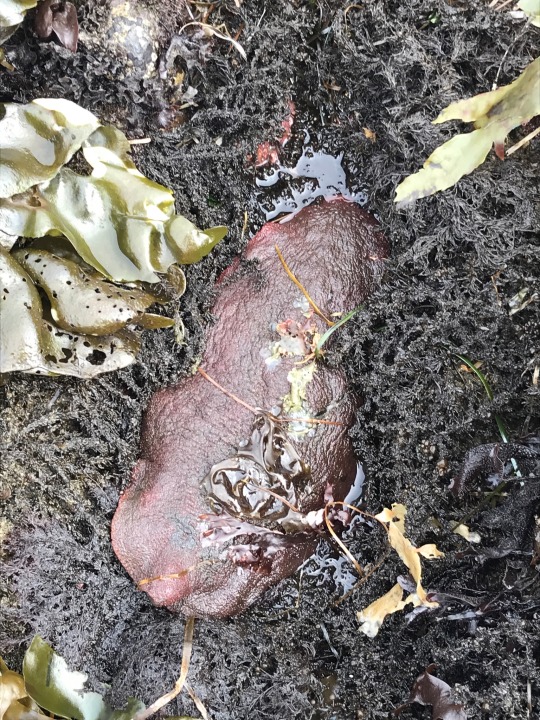
flame-lined chiton and gumboot chiton. saw about 5 or six gumboot chitons in the tidepools today, made me very happy
6 notes
·
View notes
Text
#poll#wet beast wednesday#sharks#cnidarians#crabs#fish#hydrozoan#siphonophore#marine life#marine biology
3 notes
·
View notes
Note
Showed my dad the gumboot chiton and he said "i dont know what im looking at here" so I said its a mollusk. This is the underside
yup! specifically the back end, i’m assuming his head was above the waterline. so his ass <3
2 notes
·
View notes
Text
Ay so I went tidepooling for my marine science class, right? Like legit tidepooling. We first got down to the beach we were going to check out, and our teacher, a wonderfully small man who worked at the coast aquarium for twenty years, calls me up and… hands me a gumboot chiton. And walks away. In case you don’t know, gumboots are the living equivalent of a football cut in half laterally and turned into a very leathery slug and turned slightly red. That’s literally it. So I was standing there, holding Satan’s lump of spittoon mold of a water-logged football, not know what the fuck to do with it
23 notes
·
View notes
Text
Cozy grove clams

#COZY GROVE CLAMS SERIES#
This creates a constant supply of new surfaces for even more clams to find footholds and keep the boring cycle going. Beech Grove, Winter 2022 Cemeteries Rockport LifeAfterLife TreesArePeopleToo. Cozy historical barn with modernized kitchen and restrooms. In the process of burrowing, these clams weaken the upper rocky reef layers- when a big winter storm comes along, chunks of reef slough off. Picture your guests snacking on bowls of our award-winning clam chowder, then digging into. Even little baby hermit crabs take up residence in abandoned piddock clam holes until they reach a size large enough to find a more suitable mobile home. Make sure that the 'Set time automatically' setting is turned off, then click. Then, right-click on the time and date in the lower right corner of your screen, then left-click Adjust date/time. Before you get to it, however, double-check that the game is closed. The clams bore through all kinds of rock, (except granite), to create rocky refuges for themselves and cozy condominiums for all sorts of other critters including snails, sea stars, polychaete and peanut worms, brittle stars and gumboot chitons. On PC, Cozy Grove Time Travel really only involves moving your system clock forward. Some 16 different species of not-so-boring clams call Monterey Bay home and they play an essential role in the shale and mudstone reefs lining the coastlines here. If you don't have any softwood, you'll be happy to know that you. You can turn ten pieces of hardwood into one piece of hardwood. If you speak to Jeremy Gruffle he will let you use his crafting bench, which allows you to craft freely. And, you can also get hardwood through crafting. The holes are the work of industrious molluscs called piddock clams or, more commonly, boring clams. RELATED: Cozy Grove Guide: Beginner Tips To Get You Started. A treasure trove to curious beachcombers, begs the question, “Who or what made all those holes?!”
#COZY GROVE CLAMS SERIES#
This week, a series of large winter storms delivered hundreds of strange rocks riddled with perfectly smooth drill holes.

0 notes
